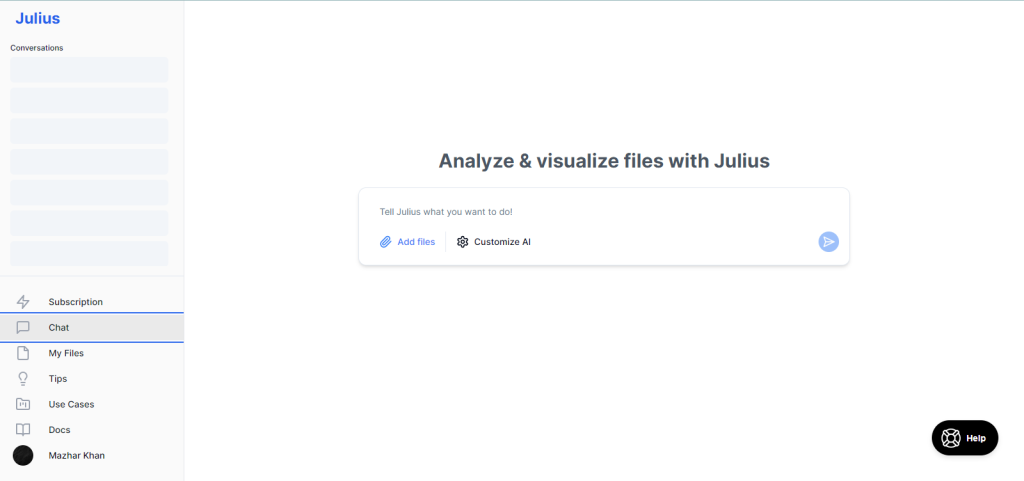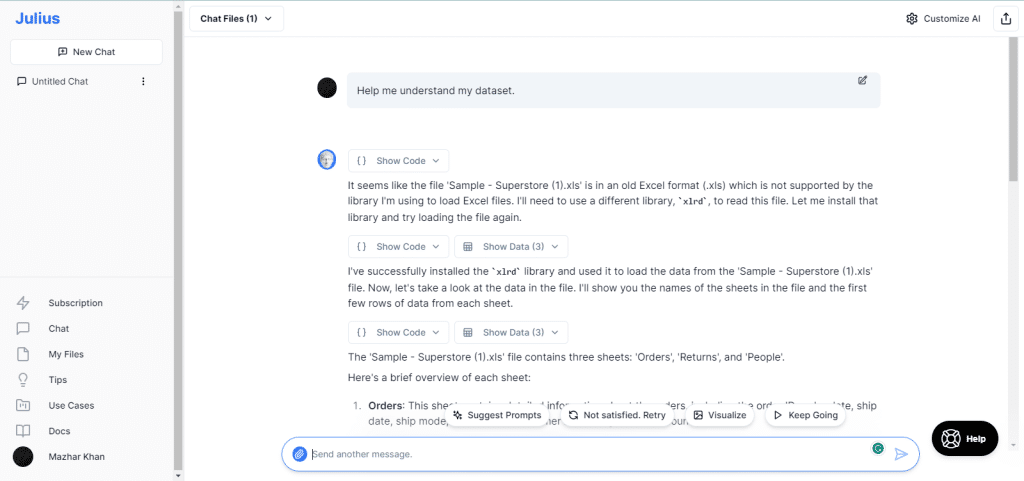
With the advent of ChatGPT, automation and efficiency became a main goal for individuals and businesses at large.
Since the launch of GPT-4, there has been an incredible increase in efficiency across different fields. One such tool, specifically for data analysts, is Julius AI, which allows you to analyze and interpret a dataset through chat prompts.
Julius AI serves as a personal data analyst, specializing in the interpretation, analysis, and visualization of structured data. It makes data analysis accessible and actionable even for individuals without a background in data science or statistics. You can analyze various forms of structured data, including spreadsheets, SQL databases, and CSV files.
Julius AI can save you hours when analyzing complex datasets. Through this article, you will learn how to use Julius AI for your data science and analytics projects.
Let’s get into it!

How to Use Julius AI
The first thing you need to do is to create an account by visiting the official website of Julius AI. You can create an account using your email or sign in directly using a Google account.

When you sign in, you will be redirected to the following page:

To start analyzing your dataset, you must first upload your data files.
To upload, click on Add files, and upload the dataset you would like to analyze.

After uploading your dataset, you are ready to start analyzing it with chat prompts.
Let’s check out 5 common use cases.
5 Use Cases of Julius AI
Now that you have uploaded the dataset, let’s understand how you can use Julius AI to analyze it.
In this section, we will go over the following use cases of Julius AI:
- Understanding Your Datasets
- Making Visualizations
- Creating Machine Learning Models
- Monitoring Key Performance Indicators (KPIs)
- Identifying Trends and Anomalies


1. Understanding Your Datasets
In cases where you don’t have a full understanding of your dataset and would like to know more about it, you can ask Julius to do it for you.
It will highlight the important details of your datasets that you must know before analyzing them.
You can use the following chat prompt for this use case:
“Help me understand my dataset.”

Julius AI will give you a complete description of your dataset.
2. Making Visualizations
Julius AI can help you create stunning visualizations using your datasets.
Let’s say I would like to have a line chart of sales over time. I can use the following prompt for this use case:
“Using the Orders sheet, create a line chart showing Sales over Time.”

Let’s also create a bar chart of Sales by Category. To do this, you can use the following prompt:
“Create a Bar Chart of Sales by Category.”

If you would like to make the above chart more visually appealing, you can use a prompt like the following:
“Can you make the Bar Chart more visually appealing?”

3. Creating Machine Learning Models with Julius AI
With Julius AI, you can create complex machine-learning models for predictions.
Suppose I would like to know the predicted sales for the next year. I can create a time series forecast model for this purpose.
“Create a Forecast model to predict the sales for the next year.”

Julius AI will make a complete model to visually show the predicted sales for the next year, as shown below:

4. Monitoring Key Performance Indicators (KPIs)
Monitoring KPIs is a crucial part of a data analytics job. With Julius AI, you can create and monitor KPIs in a single chat prompt.
To do this, you can use a prompt similar to the following:
“Create a KPI Dashboard using the Orders Sheet.”

In just a single chat prompt, Julius AI created a dashboard with all the important metrics to monitor.
5. Identifying Trends and Anomalies with Julius AI
With its data analysis and visualization features, Julius AI can help identify trends and anomalies in data sets, which can be crucial for problem-solving and capitalizing on opportunities.
You can use a prompt like the following for this use case:
“Are there any unusual spikes in sales data for the last quarter?”

Julius Ai will go through the entire dataset and look for any anomalies or trends. Once identified, it will give you the results based on the findings.
You can further drill down on it by asking the AI to help you understand what could explain these spikes.
The above are just 5 use cases of Julius AI. You can use this tool for a range of other applications, such as marketing, healthcare, academia, economics, and more.
What is The Pricing Structure of Julius AI?
Julius AI has a diverse pricing structure catering to different individuals and businesses.
The pricing structure of Julius AI is as follows:
- The Free Plan
- The Basic Plan
- The Essential Plan
- The Pro Plan


1. The Free Plan
With the free plan, you can send up to 15 messages every month.
The purpose of this plan is to allow users to try and test the platform before purchasing a paid version.
2. The Basic Plan
The basic plan of Julius AI costs $17.99 per month. When billed annually, you can get this plan for $149.99 per year, which equals $12.49 per month.
With this plan, you can:
- Send up to 250 messages per month
- Export unlimited datasets, visualizations, and dashboards
3. The Essential Plan
The essential plan costs $37.99 per month. With annual billing, you can get this plan for $319.99, which equals $26.66 per month.
With the essential plan, you can:
- Send unlimited messages
- Export unlimited datasets, visualizations, and dashboards
4. The Pro Plan
This plan costs $49.99 per month. With annual billing, you can get this plan for $419.99 per year, which equals $34.99 per month.
With the Pro Plan, you can:
- Send unlimited messages
- Export unlimited datasets, visualizations, and dashboards
- Get Access to Premium Customer Support
- Get Early Access to Premium Features
- Get Access CEO’s Cell Phone Number
Explore Advanced Data Analytics (ADA) by watching the following video:
Final Thoughts
In data analysis, having a reliable and intuitive tool by your side is invaluable. Julius AI is your data analysis companion, simplifying the complex world of data for you. Its ability to connect to various data sources eases the tedious task of data integration, making your first step into analysis a breeze.
Julius AI is user-friendly in nature. You don’t need a degree in data science to start making sense of your data.
Furthermore, with simple prompts, you can have Julius AI churning through your data, identifying trends, and visualizing insights in a manner that’s easy to understand. This ease of use doesn’t just save time, but also makes data analysis an attainable goal, regardless of your expertise level.
Opting for Julius AI could mean fostering a data-driven culture within your team or organization. By making data analysis less daunting and more accessible, it encourages everyone to engage with data, make informed decisions, and drive success.
Let’s check out some FAQs around this software.
Frequently Asked Questions
In this section, you will find some frequently asked questions you may have when exploring Julius AI.

1. What is Julius AI?
Julius AI is a personal data analyst tool that specializes in analyzing structured data.
It helps you to interpret, analyze, and visualize complex data in a user-friendly manner, making data analysis accessible to individuals without a background in data science or statistics.
2. How does Julius AI work?
You can connect various data sources like Excel Sheets, Google Sheets, and Postgres to Julius AI.
Once the data is loaded, you can ask questions or give commands, and Julius AI will perform the analysis, identify trends, and generate visualizations to provide insights on the data.
3. What are the main features of Julius AI?
Julius AI offers features like data analysis, versatile data source connectivity, data visualization, user-friendly interface, and question-driven analysis which collectively help simplify complex data analysis and visualization tasks.
4. Is there a learning curve to using Julius AI?
Julius AI is designed to be intuitive and user-friendly, reducing the learning curve significantly.
Even individuals without a background in data science or statistics can start analyzing their data with ease.
Additionally, the platform offers a question-driven analysis feature, where users can simply ask questions to get the insights they need.
5. Can Julius AI handle large datasets and complex analysis?
Julius AI is built to analyze structured data, aiding in the interpretation and visualization of complex data sets.
Its capabilities extend to handling large datasets and performing complex analysis to provide actionable insights, even if the user doesn’t have an extensive background in data science.

Be the first to comment